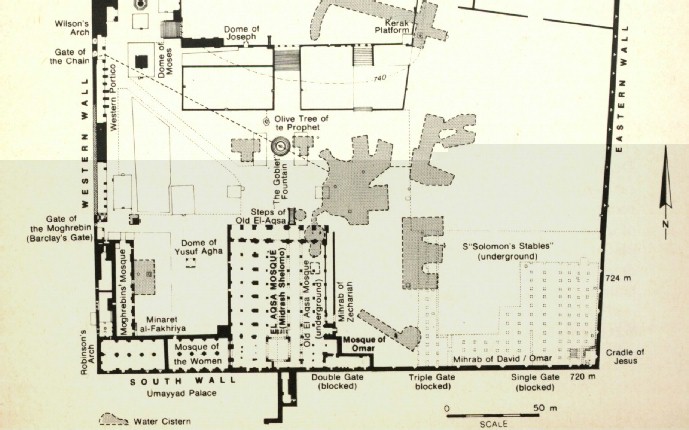"The complex measures 3,390 square metres. Its 13 arcades, rising to a height of at least nine metres, rest on 88 (or 94) piers. Once regarded as the work of King Herod, the complex is now considered to be of much later provenance, probably erected by the Umayyads (the Umayyad Caliphate ruled from 661 to 750 CE, TN) and rebuilt by the Fatimids (the Fatimid caliphate ruled from 909 till 1171 CE, TN) after the earthquake of 1033. Theoderich, in about 1169, was the first Latin to identify it as being stables built by King Solomon and to relate that the Templars kept their horses there. Holes for tethering the horses’ reins, visible in several piers, attest to this. But how did the Templars enter and exit the stables?
Scholars have assumed that the Templars opened up the entrance known as the Single Gate (location shown in the picture to the rigth, TN in order to provide access to the stables. But this gate is only 2.85 metres wide (...)" The surface of the floor of the stables slopes moderately from west to east. The surface of the south-eastern corner was raised during renovation work carried out at the site in 1890. As a result the Single Gate, nowadays blocked up, was covered up to the height of the upper arch.Also the "ventilation of this vast subterranean complex, with its (supposed, TN) single narrow entrance, would have been challenging. Did the Templars find a more satisfactory solution to the problems of access and ventilation? It is one of the windfalls of the recent conversion of ‘Solomon’s Stables’ into the ‘Marwānī Mosque’ that the Templars’ solution has become comprehensible. The conversion was initiated in 1997 by the Awqāf (the Islamic religious authorities), who in November 1999 endeavoured to open up a northern entrance to the new subterranean Marwānī Mosque and to cut a monumental staircase leading down to it from the Haram esplanade.
This (...) event revealed the existence of seven high, blocked arches in the northeastern part of the stables, of which two are now open. It has been hypothesized that all seven arches were open when the Templars owned the stables, which allowed for their ventilation and provided easy access to them; the arches were blocked under the Ayyūbids (rule (1171–1260).
The subsequent systematic sifting of the vast amount of fill that the Awqāf removed from the pit – possibly also from within the stables – and dumped outside the walls of Jerusalem’s Old City, supports this hypothesis. For among the rich assortment of finds from various periods, about 200 horseshoe nails of the so-called fiddle-key type, 60 arrowheads, opus sectile floor tiles, and more than 50 twelfth-century Frankish and European coins came to light."
Support TemplarsNow™ by becoming a Patron, tipping us or buying one of our Reliable Books


No comments:
Post a Comment